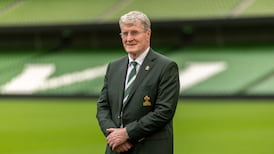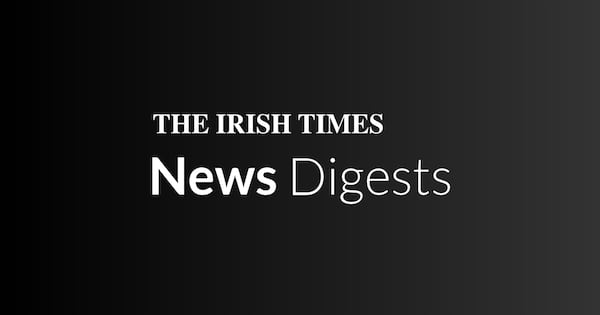Mick Dawson tells a great story about the Leinster v Munster Magners League game in October 2006. It had been moved from Donnybrook to Lansdowne Road yet come match-day only 10,000 tickets had been sold and so the Leinster branch opted not to open all the turnstiles.
In the event, such was the walk-up on the day that the official attendance was 27,252, but Dawson reckons there might have been 35,000 there.
“We had to open the gates and let almost 10,000 people in for nothing. So that was a big wake-up call. It was a different world after that.”
There had been warning signs that an unrivalled rivalry, as it were, was brewing, witness 35,000 attending the inaugural Celtic League final between the two provinces in December 2001.
READ MORE
Furthermore, there had been the Heineken Cup semi-final in 2006 when the Red Army invaded the old Lansdowne Road and turned the ground into a veritable sea of red when Munster beat Leinster 30-6. That had been an eye-opener for Dawson and Leinster.
“It galvanised me, and our coaching staff. They said we weren’t good enough on the pitch and we said we weren’t good enough off the pitch.”
By the time the sides met again in the 2009 Heineken Cup semi-final at Croke Park, it drew a then world record crowd for a club game, 82,208; Leinster winning 25-6 en route to their first of four Champions Cups in a game that marked a definitive shift in the balance of power.
This rivalry has also reimbursed the IRFU handsomely given the cost of hiring out the Aviva when fully opened is reckoned to be circa €320,000 a pop!
Indeed, it was always amazing that the IRFU and Irish rugby didn’t tap into this rivalry sooner. In the late 90s, when the sides only met once per season for the first three years of the professional era, the frontline players were regularly rested from the derby, which seems faintly ridiculous now.
Despite the success of that first 2001-02 Celtic League final, the two sides didn’t even meet in the 2002-03 season, when they were drawn in separate pools of the Celtic League, which seems even more ridiculous.
In raising the game’s profile off the pitch and standards on the pitch, arguably nothing underpinned the sharp upturn in the fortunes of the Irish team through the Noughties and into this decade more than the Munster-Leinster rivalry. A strong domestic rivalry is usually healthy for any team sport, and rugby is no different. Irish rugby is lucky to have it.
Leinster have planned for a similar attendance to that meeting in October 2006 by extending the capacity to 27,000 by opening the middle tier as well as the lower tier for this Saturday’s latest instalment between the two in the URC semi-final at the Aviva Stadium (kick-off 5.30pm).
As of Friday morning, ticket sales for the game have reached 23,600, which could be interpreted as a signal that the fixture has lost some of its lustre.
Perhaps the goose’s golden days have passed. Perhaps we can have too much of a good thing, all the more so after all those clashes behind closed doors during the lockdowns when the interpros kept the show on the road.
This game also comes in the wake of two epic days at the Aviva when Ireland beat France in the Six Nations and sealed a first Grand Slam in Dublin against England.
[ It’s no wonder Leinster have come to like their home from homeOpens in new window ]
This is also Leinster’s third Saturday in a row at the ground, and sixth game of the season at the Aviva, already a record, and were they to win that figure would rise to eight, with the final of the Champions Cup next weekend to then be followed by a URC final.
Nor do the Red Army travel in anything like the same numbers, perhaps because the Aviva has become such a graveyard in their 12-year trophy draught, and especially so against Leinster. They have lost 12 of their 13 meetings with Leinster since the Aviva reopened for business, and their only win in the last 11 clashes was in the Rainbow Cup in an RDS echo chamber.
“I personally don’t see that now,” said Leo Cullen today when asked if the fixture had lost some of its lustre.
“I think back to the most recent game on St Stephen’s Day and it was a proper cauldron down there in Thomond Park,” he added, in reference to the 25,600 full house on St Stephen’s Day.
“We wanted to try out a couple of combinations that day, properly try them out in that sort of scenario, and it was positive for us. But it was the narrowest of wins, a one-point win, and it could have gone either way. They had some chances, they would argue. We scored from a couple of those tap penalty moves that day. The occasion had a bit of everything.
“Hopefully we get a big crowd again here tomorrow. Again, there’s lots on at the moment. This sequence of games is unusual. We were talking after the game last week, it’s that sequence, is it too many playoff games to have? That’s just us saying that, because we are delighted to be here. We’re not giving out about it, it’s just a comment really.
“Specifically with the Munster game, you’ll see two sets of players giving everything and being fully committed. That’s ultimately what supporters want to see and we’ll see plenty of that.”
It’s also worth noting that this semi-final only came to pass at a week’s notice, leaving little time to market the game and sell tickets. Despite this, the attendance will not be far below the average over the last 38 clashes either side of the lockdowns, which is 31,062, so underlining this derby’s status as the biggest domestic rivalry in world rugby over the last two decades.
What’s more, the attendance will exceed the RDS capacity. In many ways, this is still a cause for celebration.















